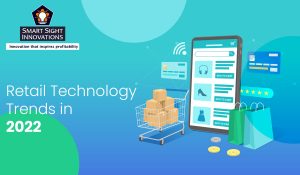 Summary: The importance of technology-enabled retail marketing is undeniable as it plays a vital role in the high-end performance of businesses and the wide distribution of products. Apart from interacting with customers and promoting products, it also allows consumers to view products before buying. Today, retailing is classified by several chains. If you are into retailing, your success depends on how well your firm does against the competition. To stay ahead in the race, technology can help achieve better results. So for your best interest in retail, it is essential to be familiar with retail technology and ruling trends.
Summary: The importance of technology-enabled retail marketing is undeniable as it plays a vital role in the high-end performance of businesses and the wide distribution of products. Apart from interacting with customers and promoting products, it also allows consumers to view products before buying. Today, retailing is classified by several chains. If you are into retailing, your success depends on how well your firm does against the competition. To stay ahead in the race, technology can help achieve better results. So for your best interest in retail, it is essential to be familiar with retail technology and ruling trends.
Disruptions due to COVID-19 have made digital transformation imminent. Retail economies have seen strong growth in 2021. Technology now plays an important role in transforming all industries, especially retail. The new normal is where consumers want to be safe and technology steps in to provide maximum ease, security and comfort with online retailing. You may want to know about current retail technology trends if you are a part of the retail industry.
-
Augmented and Virtual Reality
The retail segment has now changed to prioritize sales and the entire customer experience. Customers are attracted not only to high-quality products but also to retail experiences that create a great experience.
The rise of online retail has created a need to create engaging and personalized experiences in virtual settings. Emerging technologies such as Augmented Reality and Virtual Reality have made it possible to replicate offline experiences in online settings.
The Metaverse is the latest where customers can visit their favorite stores, browse displays, enter trial rooms and buy the items they want from the comfort of their homes.
Another example includes modular kitchen stores that allow customers to see what the fixtures they choose will look like in their real home. Some of the top eyewear brands allow customers to virtually try on their products before buying them.
-
Cashier-less shopping experience
Cashier-less shopping technology allows customers to enter the store after scanning the store’s app. They then choose the items they want and walk out without waiting at the checkout lines. Such stores are equipped with cameras and weight sensors that automatically track customers and the goods and carts they carry.
Launched in 2018 by Amazon, the cashier-less store model has proven successful and is now being deployed by many retailers.
Online stores now use cameras and sensors to track the movements of shoppers as they pick items from shelves and place them in their shopping bags. It automatically bills them when they leave the site.
Cashier-less shopping is expected to turn into a supermarket in 2022, as companies including Tesco also count on the efficiency of cashier-less shopping.
-
Use of NFTs
In 2021, sales linked to NFTs reached $13 billion.
Non-fungible tokens or NFTs are specialized digital content in the form of images, videos, tweets and audios owned by an individual. Information about tokens is stored on a secure and decentralized data record known as the blockchain.
Taco Bell, Doodle and Twitter have become popular by using NFTs. A good example is the fashion house Dolce & Gabbana. The luxury fashion label launched the Genesis Collection, an NXT drop that generated $5 million at an auction.
Brands that view NFTs as visual engaging opportunities and not just transactional relationships, know how they can be profitable in the long run.
-
Machine learning and supply chain management
Machine learning is yet another retail technology trend that is rapidly gaining momentum. Brands like Netflix and Apple use ML algorithms to capture and understand user intent to keep them engaged.
Retailers find it lucrative to invest in AI and machine learning to increase responsiveness and efficiency. The edge of machine learning in sales funnel optimization along with the increased functions of machine learning in supply chain management is substantial.
Retailers can use machine learning to automate time-consuming inventory-related operations and processes and reduce threats such as insufficient resource planning.
Machine learning aids in saving time while cutting costs and providing a quality service to the end customers due to real-time and predictive resource analysis.
-
No user interface
The pandemic has accelerated the digital transition of retail though the need for change was felt earlier. Brands and users want ways that make the human-machine connection more personal.
Today, interacting with the screen, be it computer or mobile is inevitable. But speech or voice will become functional in the user journey. The use of AI and continuous improvement in NLP (Natural Language Progression) make this possible.
Earlier, retailers were hesitant to implement zero interface retail, believing it to be a channel strategy rather than an experience. Zero interface design is another important retail trend for 2022. Soon, we may see the era of screen-less interaction or zero UI.
Devices and applications like Google Home, Apple Siri and Amazon Echo are engaging with their users without the need for a touchscreen or UI.
-
Social commerce
The social commerce development space is poised to grow. Take the example of Instagram. When it was announced that e-commerce was going to be one of the four major areas on Instagram, it was somewhat of a sketch of what was happening on the social media platform.
Social media sites speeded efforts to allow consumers to purchase products without leaving the platform. Instagram promoted this by introducing Shops to Instagram. Pinterest and Snapchat are investing in augmented reality tools and strengthening brand partnerships.
These platforms believe in investing in shopping capabilities. In one survey, the majority of consumers said that the content shown on their Facebook and Instagram feeds influenced them to make a purchase. Among the social platforms where shoppers discover and learn about products, Facebook, Instagram and Pinterest rank high.
-
Visual search shopping
Product discovery by visual search is one of the ecommerce development solutions that make the shopping experience more enjoyable. When customers search for choice products using an image they can use images instead of keywords. Visual search uses real images such as screenshots, social media images, or photos for online search and product discovery.
Visitors to your site can upload any image of the product of their choice. The visual search engine will then find the nearest products from the online catalog. This will suggest other seemingly similar items.
In the brief focus of digital shopping, visual search capabilities allow customers to do minimal work on their end. Hence, it is one of the retail trends that will only become popular with time.
-
Inventory management automation backed by data
Traditional trend forecasting is not enough to find the optimum product category to meet the demand of the target audience and certain segments.
For example, if fluorescent clothing is now in trend, it doesn’t mean that your customers will respond. If a segment demands it, then you need to understand the right customer segment to enjoy better sales figures.
Here, data-driven inventory analysis and management play a role. Your stock, present and past, can indicate what and how much your particular target audience wants to buy and how their preference will change over time.
Automated inventory management is a top retail trend and the benefits of big data based decision making include:
- Lower costs in unwanted stock, lower labor and maintenance costs.
- Increased customer loyalty with products in stock to meet demand
- More leads with ample stock positions and the best-selling products
- Smart inventory investing with revenue-generating stocks.
- Fewer discounts to get rid of unsold stock.
Over to you
Now you know about some of the prevailing retail technology trends for 2022. So are you planning to expand your retail business online? Translate your ideas into intelligent and powerful solutions with the aid of one of the top ecommerce website development services.
Hiring a professional service can help combine technical knowledge with interpersonal skills, and problem-solving expertise, and bring in improved ROI.














